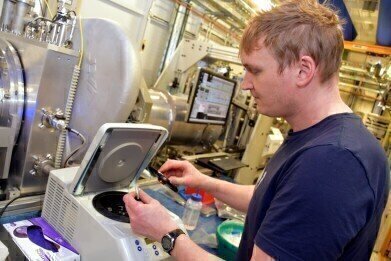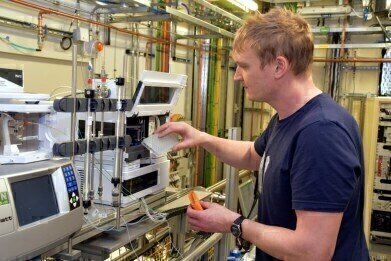News & Views
Identifying new Green Materials for Thermal Energy Storage
May 15 2020
Researchers from Aalto University in Finland have developed a technique for turning lignin from renewable biomass into hybrid nanocapsules that show potential as phase change materials (PCMs). Their recent paper (1), is the 9000th to be published as a result of research carried out at Diamond Light Source, the UK’s national synchrotron, which involved the use of light scattering and microscopy applications.
The findings represent an important step towards the sustainable expansion of PCMs in thermal energy storage applications, a key technology to reduce greenhouse gas emissions and mitigate climate change.
“Given 11 of the 12 warmest years in Europe have occurred since 2000 – we know that failure to tackle climate change will threaten human well-being, ecosystems and economies. So, with 27% of global energy consumption occurring in the residential sector and demand growing (particularly in developing countries), it is becoming increasingly important to develop methods for harvesting and storing thermal energy. One of the most promising options is based on phase-change materials (PCMs) that absorb or release large amounts of heat when they change state, e.g. from solid to liquid and vice versa. PCMs act, in effect, like rechargeable batteries, but storing thermal energy rather than electrical energy,” said principal beamline scientist at Diamond, Nathan Cowieson.
One of the most significant potential applications for PCMs is the heating and cooling of buildings as it could eventually replace energy intensive air conditioning units that increase carbon emissions. PCMs incorporated into building materials could remove excess heat during the day and release it at night, with minimum carbon emissions. Thermal energy storage (TES) can also help bridge the gap between peak energy demand and the fluctuating supply from renewable sources. However, the development of affordable TES is hampered by a reliance on fossil hydrocarbons, synthetic polymers and a lack of environmentally benign and scalable PCMs.
Profs Monika Österberg and Mika Sipponen from the Aalto University Team explained: “Dynamic systems require stable PCM suspension and one approach to maintain PCM stability is nanoconfinement in core-shell structures. Our team have been exploring simple, low-cost and scalable colloidal synthesis methods to produce hybrid nanomaterials from renewable resources. We were inspired by recent work into the encapsulation of organic molecules in lignin microparticles and nanoparticles and decided to investigate the use of lignin as a component of nanoconfined PCMs. (Lignin is a class of complex organic polymers that occur as structural materials (particularly in wood and bark) in many plants. Lignin is widely available as it is a by-product of processing wood into paper but is not currently used as PCM for thermal energy storage applications.)”
The team developed a scalable and straightforward way to produce hybrid nanocapsules using kraft lignin and fatty acids as renewable building blocks. They characterised the nanoscale morphology of the capsules using small angle X-ray scattering (SAXS) on Diamond's High-throughput SAXS beamline, B21, in combination with thermoporometry-differential scanning calorimetry, transmission electron microscopy, atomic force microscopy and dynamic light scattering. Nathan Cowieson adds; “this was a really fun experiment to do, the samples were a bit out of the ordinary for us and gave a really pretty scattering signal. Importantly the insights gained from the SAXS analysis and porosity measurements improve understanding of the formation mechanism and packing patterns of various lignin morphologies.”
Dr Paavo Penttilä from the University said: "The SAXS experiments allowed us to see the structure of the particles in their native state, that is, in the aqueous solution and without drying. In this way, we could ensure that what we saw in the electron microscopy images was indeed the real structure of the samples."
Their results showed that their water-accessible shells allowed the nanocapsules to overcome the poor thermal conductivity of lignin. They were also able to extract the hybrid capsules to obtain highly porous capsules containing only lignin.
“The 'one-pot fabrication' the team has developed allows for simple preparation of hybrid capsules with a predictable concentration of tall oil fatty acid, oleic acid, or lauric acid in core-shell particles stabilised by softwood kraft lignin. The resulting hybrid nanocapsules show outstanding performance as phase change materials, paving the way for sustainable expansion of PCMs in thermal energy storage applications. Porous lignin nanocapsules could also be explored as catalyst supports and gas separation materials,” concludes Dr Penttila.
Director of Physical Science at Diamond Light Source, Laurent Chapon concludes: “Diamond’s 9000th publication exemplifies the links between fundamental research, applied science and the technologies that move humanity forwards. Discovery may be an everyday occurrence here at Diamond, but it never loses its shine.”
(1) Sipponen MH et al. Lignin-fatty acid hybrid nanocapsules for scalable thermal energy storage in phase-change materials. Chemical Engineering Journal 124711 (2020). DOI:10.1016/j.cej.2020.124711. Published online in March 2020 and due to be printed in August 2020
Digital Edition
ILM 49.5 July
July 2024
Chromatography Articles - Understanding PFAS: Analysis and Implications Mass Spectrometry & Spectroscopy Articles - MS detection of Alzheimer’s blood-based biomarkers LIMS - Essent...
View all digital editions
Events
Jul 28 2024 San Diego, CA USA
Jul 30 2024 Jakarta, Indonesia
Jul 31 2024 Chengdu, China
ACS National Meeting - Fall 2024
Aug 18 2024 Denver, CO, USA
Aug 25 2024 Copenhagen, Denmark



.jpg)

24_06.jpg)













